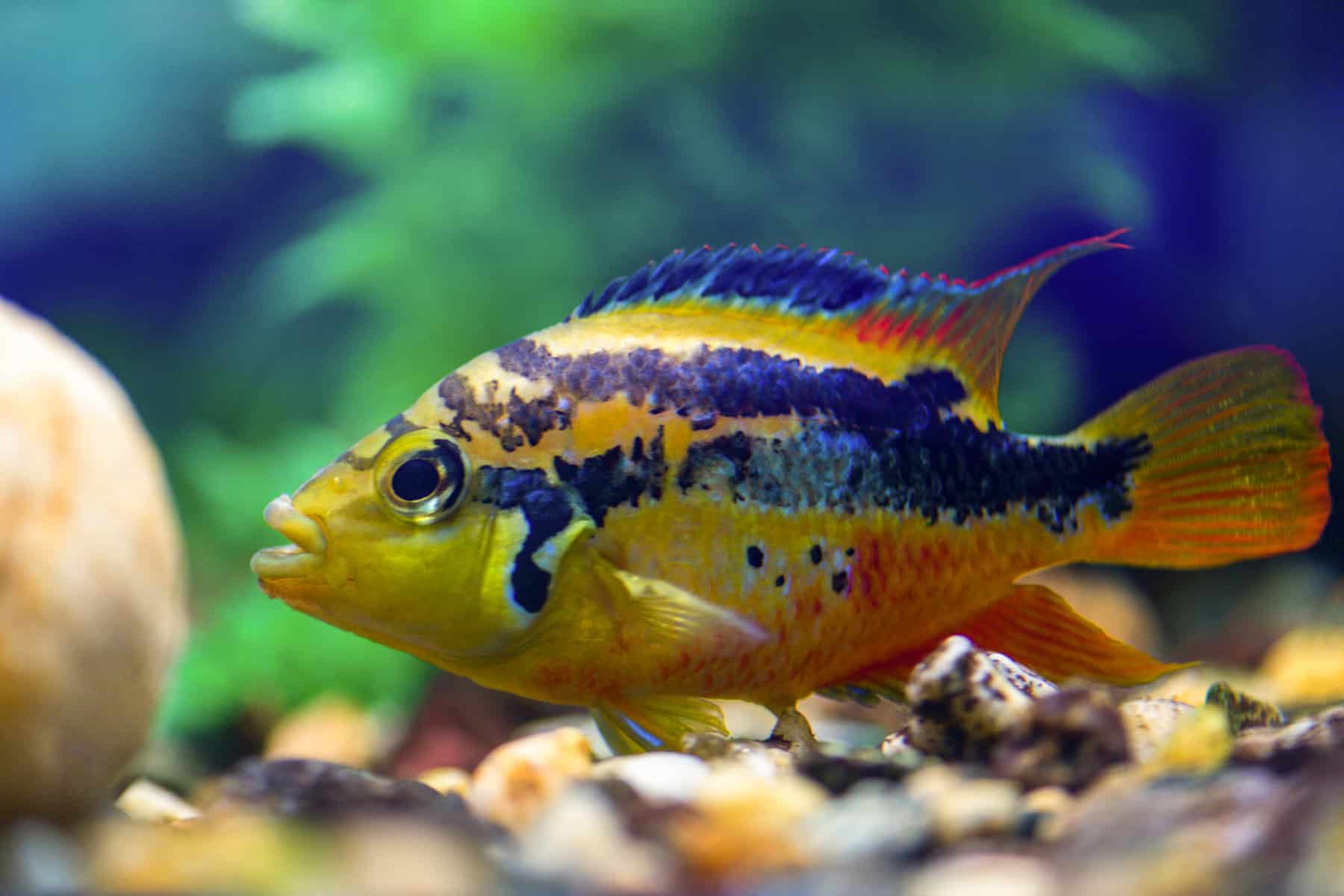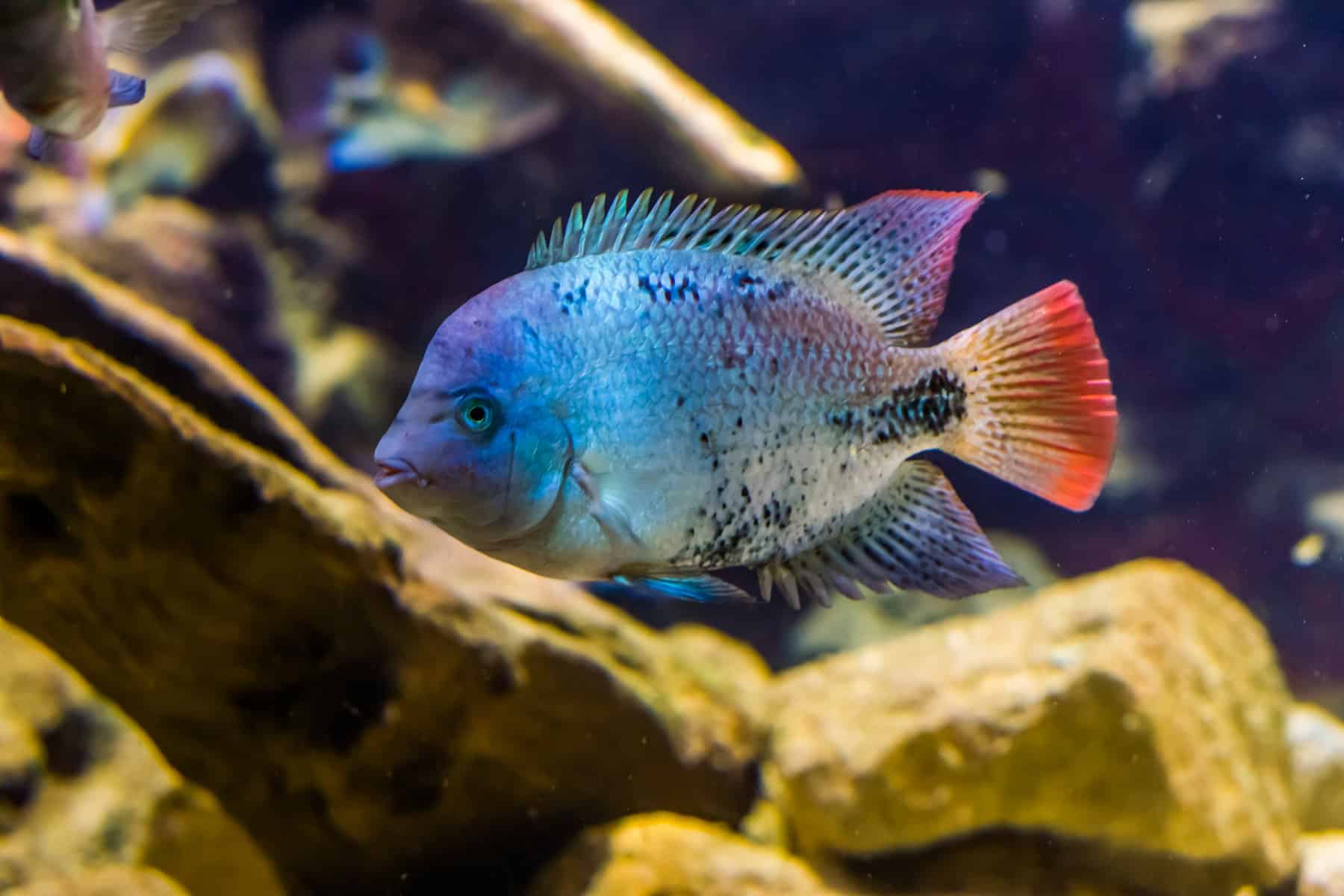[ad_1]
Cichlids are some of the most intelligent and interactive of all aquarium fish, so it’d be unusual to keep them alone.
But since they’re such a vast family, there are nuances between the species that can inform us whether to keep a cichlid in a pair with its own kind, in a community tank, or all alone.
This family of my fish is my very favorite, so it’s a treat to take a closer look at them with you.
But first, we need to understand one thing…
Cichlids Are a Diverse Family!
When people talk about cichlids, we might nod, imagining we understand what kind of fish they’re talking about. But, in reality, cichlids are a highly diverse family, consisting of more than 1,500 species of fish from three different continents that have a wide range of social behaviors and environmental needs!
Whether cichlids will enjoy being kept alone, in pairs, or in schools depends on which group we’re talking about. Let’s categorize them by the main types:
East African Cichlids
When we hear about cichlids, many of us would immediately imagine the classic African cichlids from the Great Lakes of East Africa.
There are more than 500 species of cichlid from Lake Malawi, Lake Tanganyika, and Lake Victoria, and many of them have become popular fish for home aquariums.
Keeping African Cichlids Together
African cichlids like mbunas, haps, peacock cichlids, and Lake Tanganyika Cichlids tend to be quite aggressive and territorial. Since they have specific water requirements and naturally live close together as mixed species in the wild, cichlid enthusiasts often keep them together in a specialized Great Lakes-themed tank.
Watching their interactions can be one of the most rewarding aspects of keeping these intelligent fish, so it would be very sad to keep one alone. The only exception to this would be if you were forced to isolate a fish.
Keeping African Cichlids Alone
Keeping African cichlids together only works harmoniously as long as all of the tank members are well-matched for size, strength, and aggression. If there is a weaker member of the group, they will often get picked on by the others and may need to be removed from the aquarium.
When this happens, fish keepers will sometimes isolate the smaller fish in a separate quarantine tank. But will your cichlid be happy there?
Although getting away from the aggressive tank mates might provide your pet fish with some temporary relief, it may also soon start missing company and being able to interact with other fish.
It’s quite likely that this weaker fish has a fairly submissive personality, so you could try keeping it with other more peaceful fish.
Neolamprologus multifasciatus and Lamprologus ocellatus are examples of shell-dwelling dwarf cichlids from the Great Lakes that are small and peaceful. Fish like these may make good tank mates for a shell-shocked African cichlid, at least until it fully recovers!
West African Cichlids
A lesser-known family of cichlids comes from West Africa. This small subgroup of species tends to inhabit softwater rivers rather than hardwater lakes in the wild and has quite different tank requirements and behavior.
Some of the most famous of these include kribensis cichlids, jewel cichlids, and lionhead cichlids.
Keeping West African Cichlids in Groups
Some West African cichlids are excellent community tank fish. Kribensis and other dwarf cichlids of the Pelvicachromis genus are surprisingly peaceful members of the cichlid clan that can even be kept with smaller fish such as tetras and danios in a larger tank.
But it’s important to note that, while more peaceful than many types of cichlids, these fish can still become quite territorial when breeding and guarding their fry. Other fish in the tank need to be relatively robust.
Jewel cichlids and lionhead cichlids sadly don’t share the same mild manners! These fish are always aggressive to their own species unless they decide to form a mated pair.
The best way of doing this is to raise males and females together from an early age and let them pair off. Only one pair can be kept in a tank – the others will be killed if not removed!
Keeping West African Cichlids Alone
Because West African dwarf cichlids become more aggressive during spawning time, some people prefer to keep only one of them in a community tank.
I kept a single beautiful female kribensis in my community tank with black skirt tetra, cardinal tetra, and corydoras catfish without problems.
She seemed quite content guarding her cave, but the fact she was digging gravel pits may have meant she was feeling broody and missing the company of a male.
Jewel cichlids and lionhead cichlids are too aggressive for community tanks, and it’d be tragic to keep these magnificent fish completely isolated too. They’re classic single-species tank fish to be kept in breeding pairs and will become much more colorful when breeding as well.
South American Cichlids
South American cichlids often tend to be more peaceful than their African cousins. Classic examples include angelfish, discus, and severums.
But the inclusion of the notorious oscar in this group reveals that the general rule about their peaceful ways isn’t always true!
Keeping South American Cichlids in Groups
South American cichlids are some of the most amenable to community tanks of all cichlids. Angelfish are classic community tank fish when kept with other larger, robust fish from the Amazon.
But you should always keep angels in groups. Even with the company of other fish species, angels will miss the presence of their own kind, and it will also deny them the opportunity to breed.
Discus are also schooling fish that should be kept in groups of six or more in a specialist tank setup, but they may be content sharing a breeding tank with their mated pair for a limited time too.
Keeping South American Cichlids Alone
Predatory South American cichlids like Oscars are almost always kept alone except when breeding. But this is no easy feat either since Oscars will sometimes kill their mate during the courtship process!
But some calm cichlid species such as severums can also be kept solo in community tanks.
I used to keep a gorgeous female gold severum with all kinds of medium-large compatible tank mates and I never once saw her show any signs of aggression. In pairs, of course, these fish will become more territorial as they guard their brood.
Central American Cichlids

Central American cichlids have a reputation for being some of the fiercest members of the tribe, but once again, not always! Jack Dempsey cichlids, Texas cichlids, Firemouth cichlids, and Salvini’s cichlids are indeed all notoriously aggressive.
But Central American dwarf cichlids such as ram cichlids and rainbow cichlids are some of the most peaceful members of the whole family, and the occasionally feisty convict cichlid is somewhere in between.
Keeping Central American Cichlids in Groups
Some avid cichlid keepers have tried keeping similar species of aggressive Central American cichlids in groups together, but it’s a risky business.
If all of the members of the group are fairly well-matched in size and aggression, it might work out. But more often than not, a certain species or individual will become more fired up than the others and endanger the lives of their tank mates.
Peaceful dwarf central American cichlids such as ram cichlids and rainbow cichlids can make excellent community tank fish with a mixture of other species and can live alongside one another too.
Convict cichlids are somewhere in the middle of these two extremes and can sometimes be kept in large community tanks as long as the other fish are robust or fast enough to get out of there during breeding season!
Keeping Central American Cichlids Alone
Since these species of fish are intelligent and sociable, it’s not normally recommended to keep them on their own. Central American cichlids can be great fun to breed, so keeping a pair will be much more fun for you and your fish than keeping them in isolation.
Since convict cichlids are only border-line community tank fish, some people have tried keeping just one of them so that they don’t become dangerous during courtship and breeding time.
I wonder if these fish would live fulfilled lives without the opportunity to spawn, and I feel that if you’d like to keep convict cichlids, you should either provide a pair with their own tank or keep them with other large, robust potential tank mates.
Hybrid Cichlids

There is a group of cichlids that don’t fit so neatly into any of the above categories because they don’t naturally occur anywhere in the wild.
These man-made hybrid species such as the blood parrot cichlid are a genetic mix of different natural species that has produced something that would never have been produced in the wild.
While some people say that blood parrot cichlids can be kept alone or in groups, I’d rather not join the discussion because I don’t feel it’s ethical to breed species that exhibit genetic abnormalities that could cause them to suffer.
Blood parrot cichlids, for example, have very small mouths that make it difficult for them to feed adequately.
Since the natural world gave us more than a thousand natural species of stunning cichlids to admire, surely we don’t need to breed mutated forms simply for entertainment.
Cichlids for a Community Tank
Among the different groups of cichlids, I’ve pointed out some species that can be successfully kept in community tanks. Let’s recap some of the best.
Angelfish and severums can make spectacular community tank fish so long as the aquarium is big enough and their tank mates are fairly large and robust. Angelfish have been known to eat neon tetra, after all!
To share a fish tank with smaller fish, dwarf cichlids like ram cichlids, rainbow cichlids, and kribensis are great for softwater tanks, and African shell-dwellers make a fascinating addition to hardwater community aquariums.
In Summary
Cichlids are a diverse family but tend to be highly intelligent and enjoy social interaction. Keeping cichlids in pairs or small groups gives these fish the chance to enjoy socializing, as well as mating, spawning, and looking after their young – an unforgettable process to witness as a fish keeper!
Aggression during breeding may push some people to keep a single cichlid in a community tank, but these fish should never be kept completely isolated, apart from in exceptional circumstances when there’s no other option.
[ad_2]
Source link
